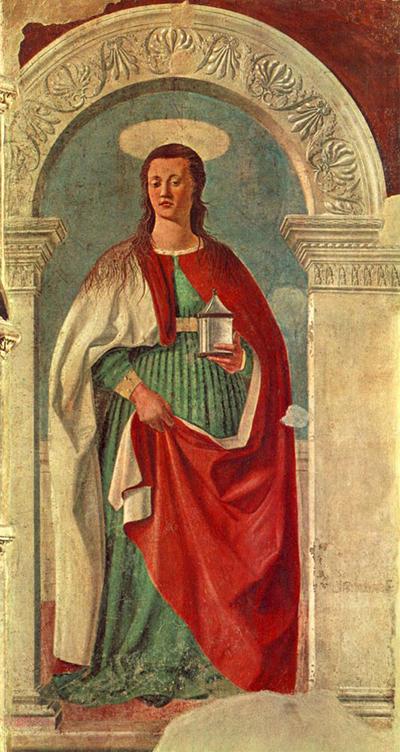Admirers of Piero della Francesca will find plenty to please them in the Cattedrale di Ss. Donato e Pietro, the medieval cathedral dedicated to Saint Francis of Assisi in the Italian city of Arezzo.
Its Cappella Maggiore boasts three of his frescoes entitled Legend of the True Cross, and it was while he was working on this San Francesco cycle that Piero received a commission to produce a 190 x 105cm fresco of Saint Mary Magdalen for the wall near the church's sacristy door, which he completed in 1460.
Reminiscent of the early sixteenth-century Venetian style, generous areas of bright warm colours dominate the substantial and imposing figure, although the halo, dress sleeves and belt are no longer gold in tone. The kind of detail so typical of the artist's later output is in evidence here, with reflections of light, creases in the saint's robes, hair texture, and engraving on the marble archway all given full attention. Beyond this, the blue sky suggests distance and fixes the action in the foreground, while the light source comes from the front, behind the viewer, and plays over both figure and architecture, bouncing off the garments in particular. Her strikingly strong and determined features suggest that she was nobody's fool, and della Francesca made sure that it was impossible for those passing through the cathedral to ignore her.
The Renaissance mind questioned everything, and Piero della Francesca used his scolar's interest in mathematics to develop an understanding of perspective. Artists were beginning to grasp this concept at the time, and Piero made full use of his expertise in this fresco, so that Mary Magdalene really appears to be passing under an arch, with one side of her body slightly sideways as she negotiates the structure, and shifts in balance as she moves towards the step.
An early-Renaissance painter who was appreciated more for his mathematical theories than for his innovative artworks among his contemporaries, Piero della Francesca is now highly regarded as an artist, and as a pioneer in the use of space in painting, so evident in the Saint Mary Magdalene fresco. In this, he may have been inspired by the techniques of Domenico Veneziano and Antonio di Giovanni Anghiari during a period in Florence, and also by the earlier work of Uccello. In turn, the natural style of his canvases and frescoes influenced younger artists such as Perugino and Luca Signorelli, who carried his ideas forward and developed them.




